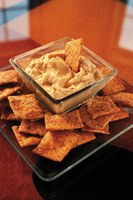Prairie Fare: Stay on the Pulse of Healthful Eating
(Click an image below to view a high-resolution image that can be downloaded)
By Julie Garden-Robinson, Food and Nutrition Specialist
NDSU Extension
Can you find your pulse?
Try placing your index and third finger on the side of your neck to the side of your windpipe. You also can check your pulse on your wrist.
Once you find your pulse, count the number of beats you feel in 15 seconds and multiply by four to determine your heart rate.
Lots of factors can influence your heart rate, including your age, emotional state, smoking status, fitness level, body position and medications. On average, a pulse rate between 60 and 100 beats per minute is considered “normal,” but check with your health-care provider for advice.
February is American Heart Month. It’s a good month to pay special attention to your heart health and assess your lifestyle.
Your trusty “ticker” circulates oxygen and life-supporting nutrients throughout your body day after day. Your heart beats, on average, 100,000 times per day for a very long time if you take care of it.
“Pulse” also refers to a category of legumes with seeds that grow in pods. Feb. 10 is World Pulses Day, and these budget-friendly foods are good for our heart. We grow pulses in abundance in North Dakota and surrounding states.
These ancient crops have been used in worldwide cuisine for thousands of years. According to the international definition, dry beans, dry broad beans, dry peas, chickpeas, cow peas, pigeon peas, lentils, Bambara beans, vetches, lupins and “pulses not elsewhere specified” are the 11 types of pulses.
I will admit I have not cooked all these types of pulses, but now I’m intrigued to find them.
Pulse foods are rich sources of protein, fiber, vitamins such as folate, and minerals such as iron and potassium. They are low in fat and sodium, and are naturally gluten- and cholesterol-free. Researchers have reported that regular consumption of pulses may reduce the risk of heart disease, diabetes and certain types of cancer.
Sometimes we don’t try foods because we are not sure how to prepare them. We can buy pulses in canned or dry form. They are virtually sodium-free if we start with dry pulses, so they are not adding excess sodium to our diet.
Here’s how to use chickpeas/garbanzo beans starting from the dry form:
- Remove any small stones, then place in a strainer and rinse with water.
- Soak prior to cooking.
The following methods may be used to soak chickpeas:
- In the traditional slow soak, cover 1 pound of dry chickpeas with 10 cups of water and refrigerate six to eight hours or overnight.
- When using the hot-soak method, bring 10 cups of water to a boil in a sauce pot, add 1 pound of dry chickpeas and return to a boil. Allow to stand at room temperature for two to three hours.
- To use the quick-soak method, bring 10 cups of water to a boil, then add 1 pound of dry chickpeas. Boil two to three minutes. Allow to stand at room temperature for one hour.
To cook soaked chickpeas, drain and rinse them, then add 2 cups of unsalted water for every cup of chickpeas. Simmer for 90 minutes to two hours, then use in your favorite recipes.
The yield for 1 cup of dry chickpeas plus 2 cups of water is about 2 cups of cooked chickpeas.
In February, heart health is the focus on our “Nourish and Exercise Your Body” website. Try Googling the website title along with NDSU Extension.
We also have an abundance of pulse recipes. Visit https://www.ag.ndsu.edu/food/pulse-crops to check out our pulse recipes.
Here’s one of my favorite recipes for an easy and inexpensive snack. You can begin with dry chickpeas or use drained, rinsed canned chickpeas.
Savory Garlic Hummus
1 (15 1/2-ounce) can chickpeas or 2 c. cooked chickpeas
4 Tbsp. tahini (sesame paste)
1/4 c. lemon juice
3 cloves crushed garlic
1 tsp. salt (or less to taste)
Puree peas in blender or food processor. Add remaining ingredients and blend until smooth. The final product should be thick and smooth. Serve with a variety of colorful vegetables or whole-grain crackers.
Makes 12 servings. Each serving has 70 calories, 3 grams (g) fat, 3 g protein, 8 g carbohydrate, 2 g fiber and 200 milligrams sodium.
(Julie Garden-Robinson, Ph.D., R.D., L.R.D., is a North Dakota State University Extension food and nutrition specialist and professor in the Department of Health, Nutrition and Exercise Sciences. Follow her on Twitter @jgardenrobinson)
NDSU Agriculture Communication - Jan. 31, 2019
| Source: | Julie Garden-Robinson, 701-231-7187, julie.garden-robinson@ndsu.edu |
|---|---|
| Editor: | Ellen Crawford, 701-231-5391, ellen.crawford@ndsu.edu |



